FAMILY TREES
Lamb shanks, afval and living history at Muratie
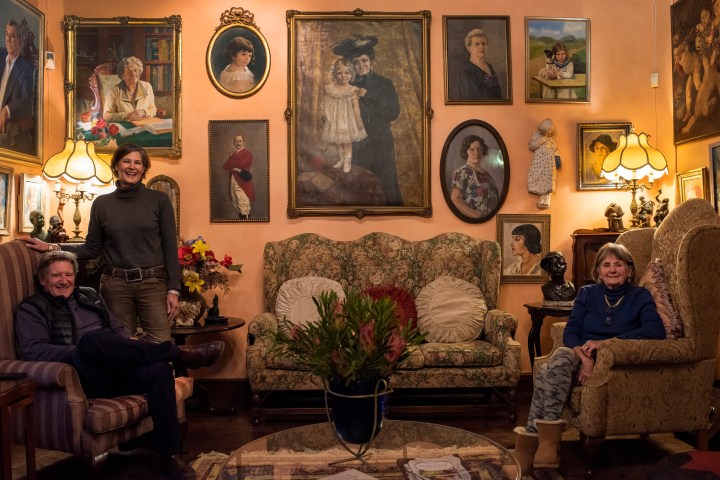
Annatjie Melck’s kitchen in the old Muratie homestead is at the heart of the family-owned Stellenbosch wine estate’s food story, from lamb afval to lamb shanks and home baking.
Rijk Melck takes us through the back door into his mother’s kitchen in the manor house at Muratie, where Annatjie Melck and Johanna Davids are putting the finishing touches to this week’s batch of lamb afval (offal). A small fire is burning in a huge open hearth. It’s an old farm kitchen full of character with not a fitted cupboard in sight. A big loaf of Johanna’s bread is cooling on a rack and Saartjie, Rijk’s German Shepherd, follows us in to check whether food talk will result in a snack in her metal food bowl, which she rattles hopefully on the tile floor under a table.
On a recent visit to the Muratie Farm Kitchen we’d feasted on a glorious lamb shank and superb red roman in Chardonnay cream cooked by chef Riaan van Schalkwyk, so why am I now back in pursuit of the less than glamorous afval, which is also a fixture on the restaurant’s authentic farm menu? Well, Muratie is all about stories, many of which destination manager, Lawrence White, had shared with us during our wine tasting, but tracing Muratie’s food story back through the years, Annatjie’s lamb afval is a continuous thread that connects past and present. A perhaps unobtrusive thread that I hadn’t picked up on properly, and which promised even more stories. A second visit was in order.
Rijk dives into the larder saying, “You’re not squeamish, are you?” and returns with a neatly frozen pack of cleaned, uncooked afval. “The big thing is it’s got to be clean, the sheep must be healthy if you’re cooking the head and organs. In the old days Annatjie used to get it from her brother who farmed in the Karoo. He passed away, so now she has a supplier near Williston.”
Annatjie points out the various components, “This would be the stomach all clean, here are the legs, the head with the brains, eyes, the delicate parts tucked inside, the nose part is cut away, tongue, the cheeks. To one pack of afval I add half a lamb neck, to give it a bit more substance.” The brains are considered an especial delicacy but are small, only enough to be included in one of the eight portions made from each pack, which Annatjie marks with an X for those in the know.
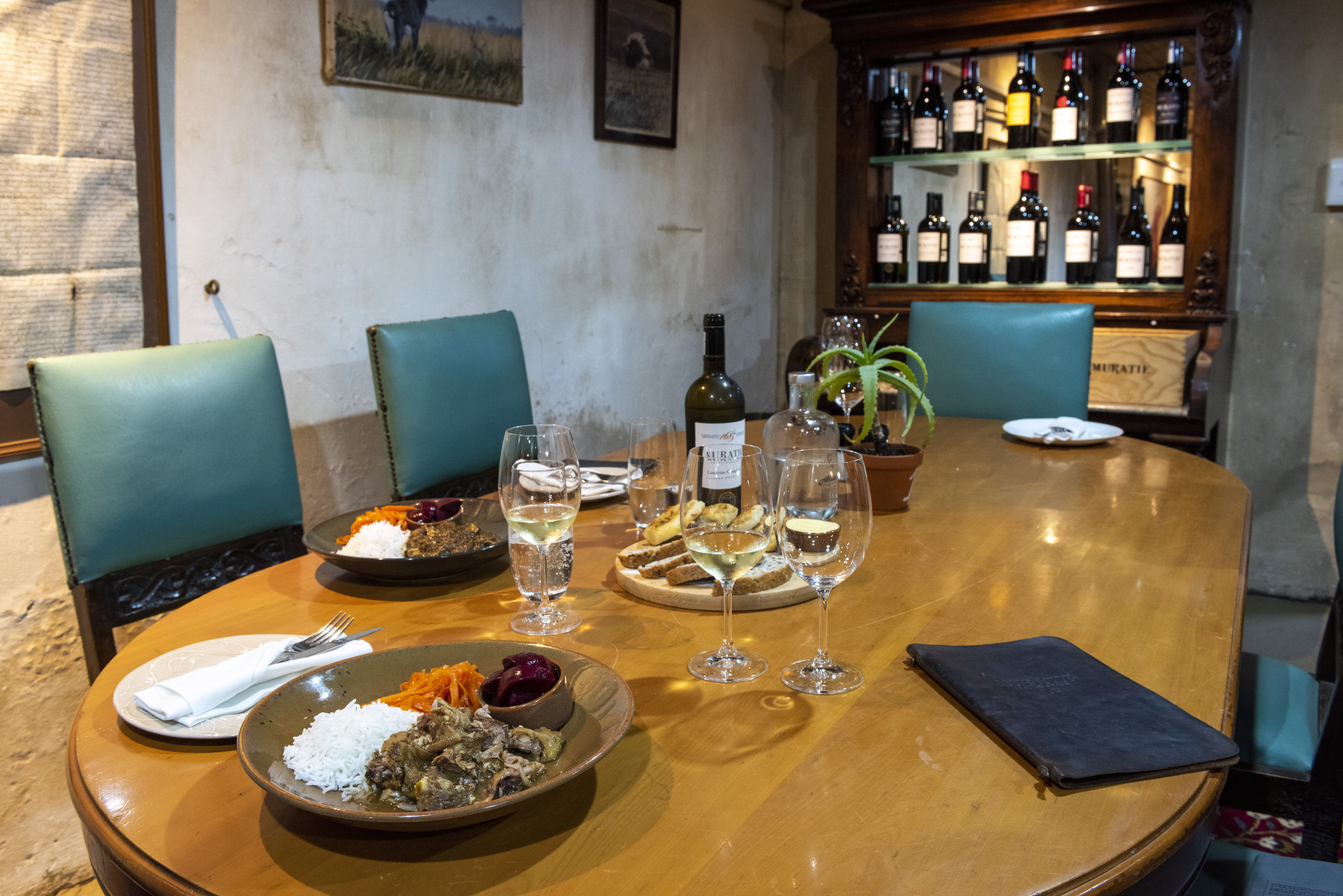
A side-by-side tasting of Annatjie Melck’s and Chef Riaan van Schalkwyk’s afval dishes with plenty of delicious farm breads to mop up the juices. (Photo: Patrick Heathcock)
“The main thing is to keep the taste as natural as possible, not to put wine and stuff in,” she says. “I put a tiny bit of curry and turmeric in … when I grew up in the Karoo the ladies of the house would clean it themselves, put it in the fire to scorch, then scrape the wool off, which left some flavour. Nowadays they do that with chemicals, so it tastes too clean without some spices.” She cooks it overnight in the slow cooker for 12 hours. “It’s got to make that gelatine and come free from the bones, you mustn’t make it anxious.”
Annatjie is making this batch for sale at Oom Samie se Winkel, a traditional general trading store in Stellenbosch that she and some friends revived in 1981 and named after the original owner, Oom Samie. It’s the place to go whenever you’re nostalgic for bokkoms, sour fig jam, old-fashioned baked treats and sweets, vintage books and treasures. At 89 she no longer owns it, her daughter Charla Kriel recently took it over, but she’s still supplying this one traditional dish. “It’s amazing how many afval eaters there are, it’s very possibly the same clients who keep on asking for it and I wonder how long I can do this,” she says. She’s taught the restaurant team her recipe and method so they can continue the tradition. “I bring them down every now and then to recalibrate,” says Rijk.
Annatjie’s right-hand woman and her eyes in the kitchen now that her eyesight is going, is Johanna, who has lived and worked at Muratie since she started working in the vineyards at 14. She may now be retired and in her 80s, but is still as involved in farm life as ever and very much part of the family.
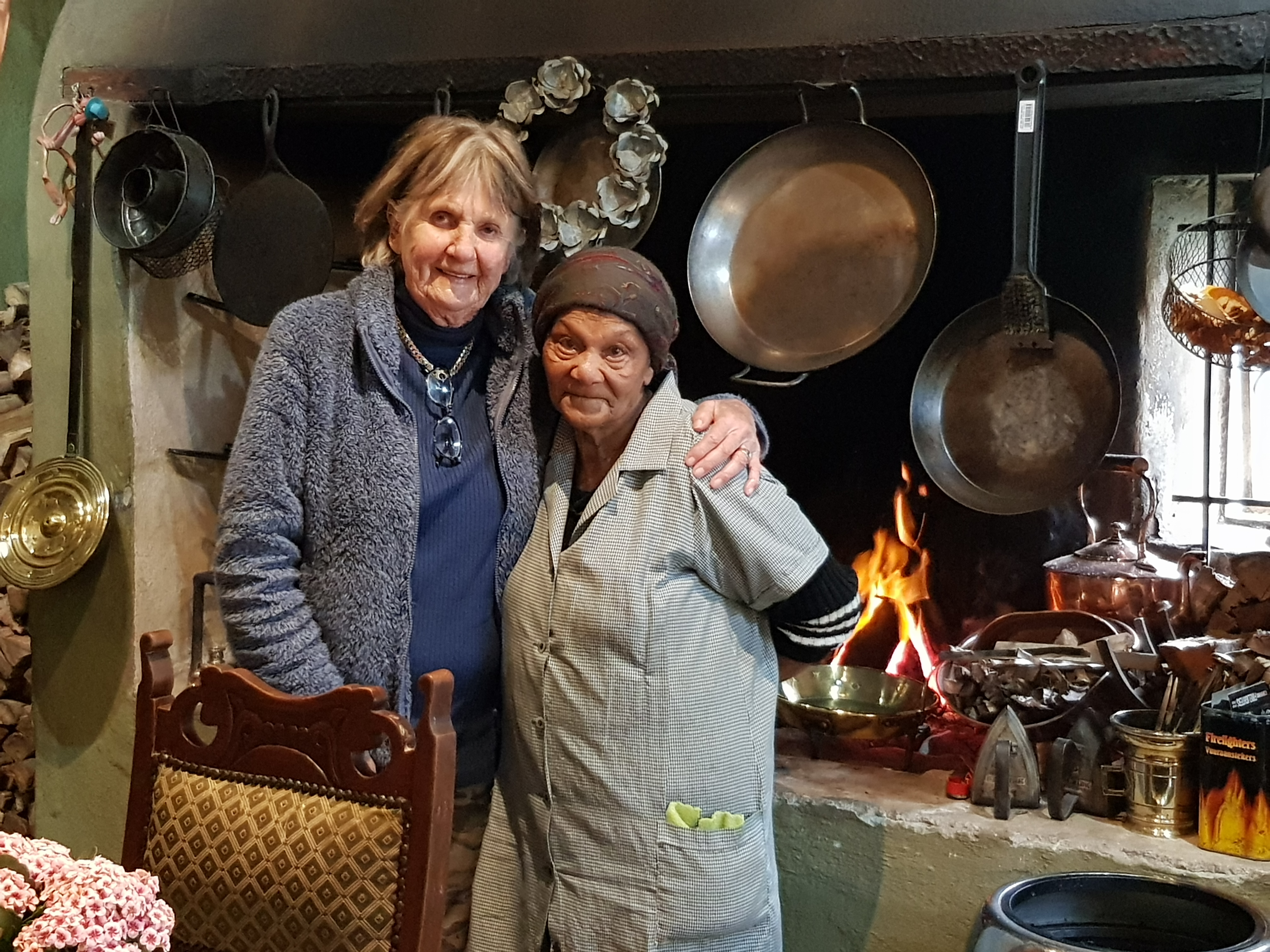
Annatjie Melck and Johanna Davids are a formidable team in the kitchen, cooking up weekly batches of Annatjie’s famous lamb afval for sale at Oom Samie se Winkel in Stellenbosch. (Photo: Patrick Heathcock)
A narrow corridor connects the kitchen to a formal dining room, where coffee is laid out for us, and we take it through to the lounge where a fire is burning to ward off the chilly wet winter day. Rijk tells me his theory as to why Annatjie’s afval, such a humble dish, is still in constant demand.
“It started here 10 years ago or so. Christo Wiese, Whitey Basson, GT Ferreira (Stellenbosch’s best-known billionaire businessmen), all these Afrikaner okes used to come eat afval here. GT grew up in Graaff-Reinet, his dad was a policeman, Whitey was from Porterville, Christo from Upington, they all grew up tough, they were not wealthy kids. So I think it’s a comfort food for these guys, a yearning to go back to their roots.”
This was in the days before Muratie had a restaurant, and they would eat in the dining room here at the Manor House, a regular Friday business-lunch ritual of afval served with rice, beetroot and Johanna’s fresh baked bread, sitting long after lunch talking business and playing matches for the bill. He chuckles as he remembers one occasion, “I came back to check everything was fine, only to find that the table was empty and they were all through here in the lounge, four or five okes sitting on this couch upright. Johanna had chucked them out to clear the table. She’s the boss here.”
The couch is elegant and old fashioned and the wall behind it, in fact the whole room, is filled with paintings, mostly portraits. Rijk points out two of Alberta Annamarie Canitz, the previous owner of Muratie (affectionately known as Annamie), who Johanna looked after as an old lady, and as he talks we get a sense that the previous owners of the farm are considered part of their family. Like his mother, Rijk’s intrigued by history and they have made a point of gathering together all the Muratie stories as part of the farm experience. All the wines are named after a notable character from the farm history. Only two wines are named after living people (the rosé honours Johanna, the chardonnay is named after Rijk and Kim’s first daughter Isabella), otherwise each wine comes with a story from the past.
During our first visit, as we tasted the lively Laurens Campher white blend, Lawrence recounted the very beginnings of the farm when its founder, Laurens Campher, too poor to own a horse, would walk for three days to Cape Town each month to visit his love, Ansela van de Caab, who was a slave at the Cape Town Castle. He finally managed to gain her freedom and brought her and their three children back to the farm, where on their wedding day in 1699 they planted the huge oak tree that today shelters the cellars and tasting room.
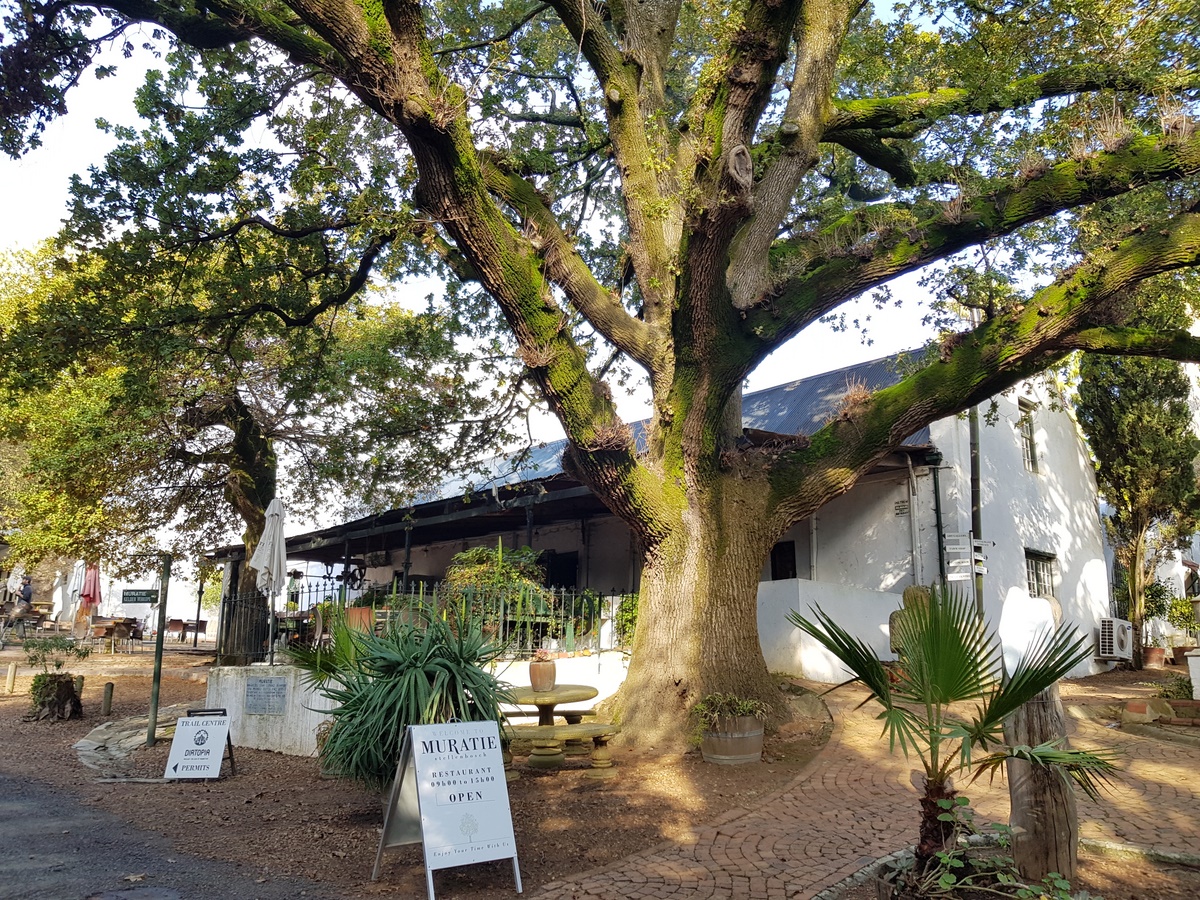
The majestic oak tree planted by the founder of the farm, Laurens Campher, and Ansela van de Caab on their wedding day in 1699. (Photo: Kit Heathcock)
The farm was owned by Melck family ancestors from 1763 to 1897, and then from 1927 by bohemian artist George Paul Canitz, followed by his daughter Alberta Annemarie 1958-1987. As we look at her portraits, one as a child, the other as a mature woman, which take pride of place on the lounge wall, Annatjie begins the story of how the farm returned to the Melck family, to her husband, Ronnie.
“Ronnie met Canitz when he was a student, they would come and buy wine here for their hostel dance in about 1951. He instinctively liked this man and his style. I don’t think Ronnie knew at the time that this was a Melck farm before. Annamie was a horse rider, a tiny woman, she rode these big horses, so a ramp was built for her outside the kitchen. She told me about riding on her horse down Ryneveldstraat in Stellenbosch and seeing three young men walking past her towards the university and one of those young people was such a beautiful man… that was Ronnie. Later Ronnie started working for Stellenbosch Farmers Winery as a wine buyer, and came here buying grapes for the co-op and got to know Annamie. He always looked after her, he’d come at Christmas time and bring her a ham or some kind of gift, as she was alone.”
Annamie had no heirs and a lot of the big names in the wine industry such as Thelema, Villiera, Rupert, including their immediate neighbours Delheim, were interested in buying the farm, but Annatjie remembers Annamie telling her, “I would not sell to them because they have too much money – they will spoil Daddy’s legacy. They would take away things.”
So she chose to sell to Ronnie, and in the Melcks she found custodians for Muratie who shared her understanding of the spirit of the place. Annatjie says, “When we moved into Muratie, these historical fundis came and wanted to put a blue plaque on the wall. It is one of the oldest living farms, all the original buildings are still here, but they said we must remove all the add-ons. Now Canitz loved his farm and his house and did whatever he wanted to make it beautiful, the way he liked it. He added on the vestibule at the front door, he went and bought windows and pillars when other buildings were demolished and would use them here. They wanted us to remove all that. I said, no no no, it’s all part of the story, these people lived here, were happy here, it’s staying this way. So we never got the plaque.”
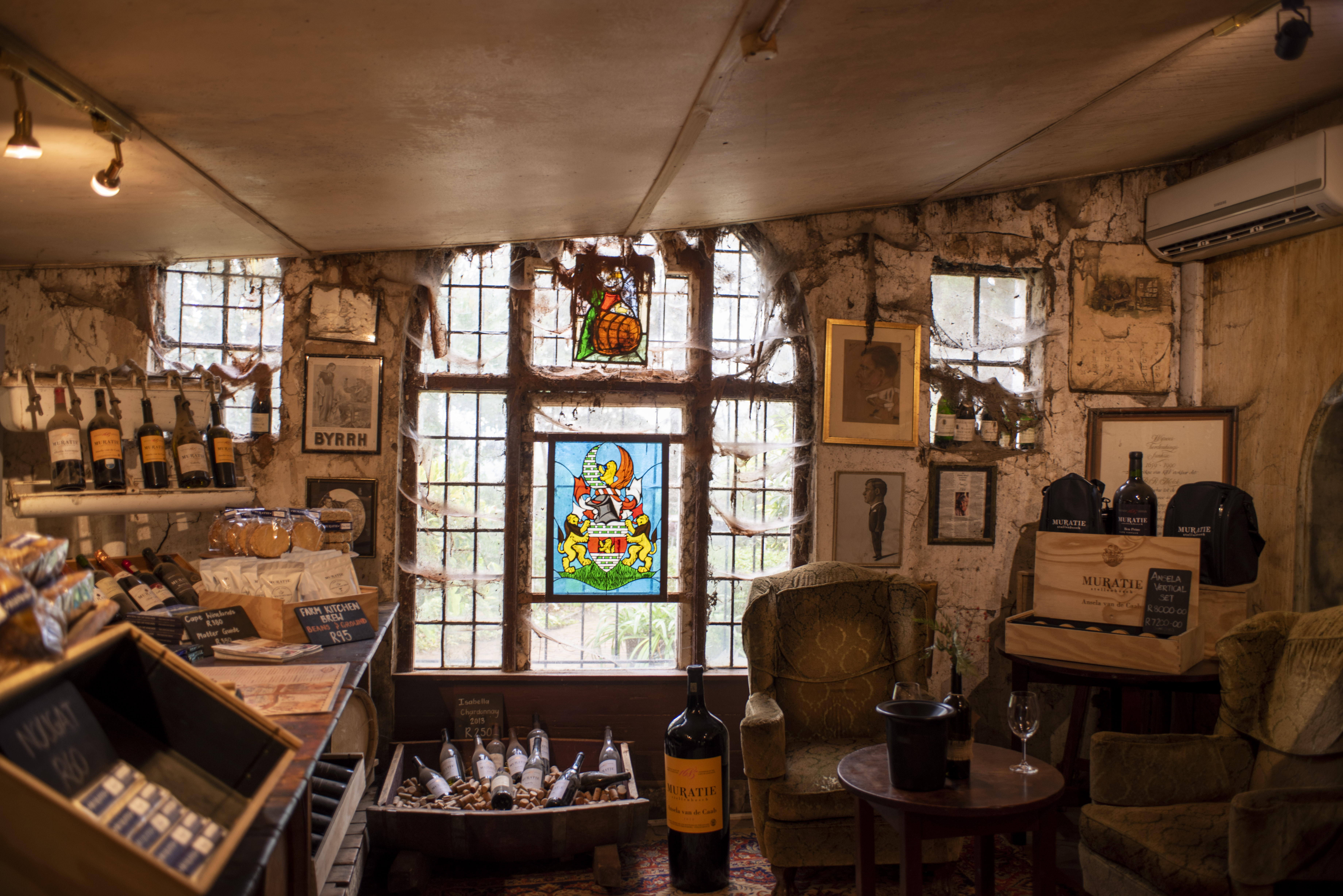
The legendary Muratie cobwebs date back 50 years or more and festoon the windows in the tasting room and cellars, but not, as Annatjie Melck emphasises, in the restaurant. (Photo: Patrick Heathcock)
It’s the same with the impressively gothic cobwebs, long part of the Muratie legend. The very same cobwebs that Annemie Canitz deliberately left festooned in the cellars to trap the flies (several friends who were students back in the ’70s and ’80s remember Muratie with nostalgia for two things: cobwebs and port tastings) still hang in the windows of the tasting room and cellar today. Annatjie says, “The cobwebs we found here, and I said to leave them there, they seem to be very happy. But not in the restaurant.” And Rijk remembers a tussle with the insurance company and having to argue the case for the cobwebs having a cultural significance. A compromise was reached. They now have a smoke alarm and keep the cultural cobwebs.
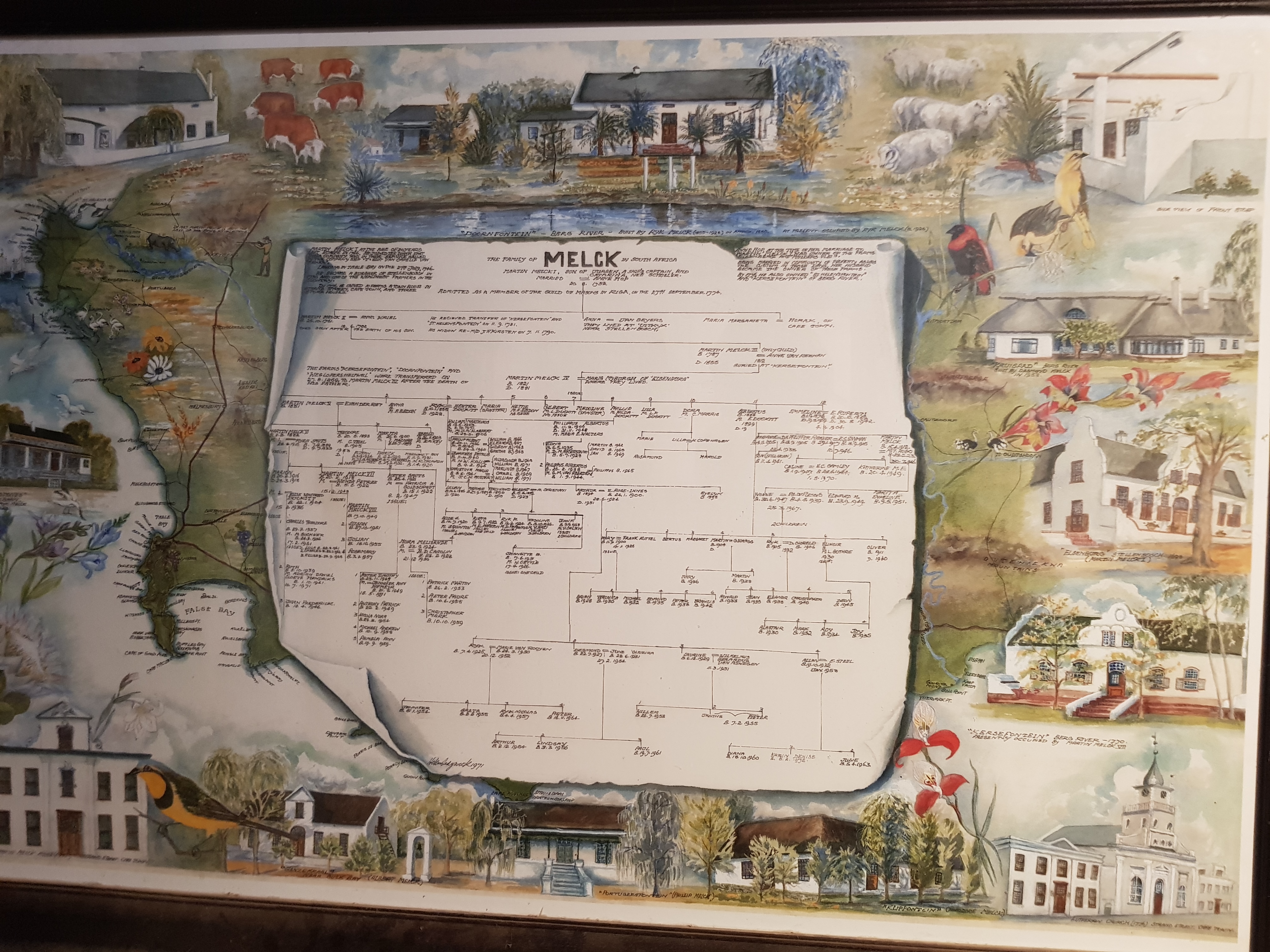
An illustrated family tree of the Melck family hangs in the cellars, going back through the generations that owned Muratie in the 18th and 19th centuries. (Photo: Patrick Heathcock)
“Muratie was very rundown when my dad bought it in 1987,” Rijk says. “The cellar was really primitive, the wine running in a furrow, not pipes. The nice thing is – we didn’t have a bottomless pit of cash, we had to do a little here, save up and do the next thing.” Sadly Ronnie fell ill soon after buying the farm, so although he got agricultural economists and viticulturalists in and started planning and planting, there was a slow start to Muratie’s next chapter. When Rijk moved here with his young family in 1997, he was still working as a doctor in Stellenbosch, but he quickly got a feel for the land. “I used to walk around the farm every evening, I could feel where the air was hot or cold, so we realised what to plant where. This is real wine farming, wine making. It’s not an ego thing here, we do it because we love it and we are aware of the environment. We have a nice complement of staff who have grown with us. We’ve come a long way from where we were.”
We’ve also wandered a long way from the food thread and I ask if there are any food stories from earlier days. Annatjie laughs, “Canitz had no money – if you read stories about him, when friends came over it was sandwiches, but everybody was happy, they drank wine and ate sandwiches. I still think we should serve sandwiches.”
And there’s a recipe for a famous wheel of a Madeira cake that Johanna used to bake for Annamie Canitz every Friday, which they would liberally douse with Muratie’s elegant muscat dessert wine, Forever Amber (named for the artist’s muse, and another fascinating story), to have with tea.

Annatjie Melck wrote her cookbook Koljander to collect all her recipes and memories of life growing up in the Karoo. (Photo: Patrick Heathcock)
Rijk shows me a copy of Annatjie’s cookbook Koljander, Koljander so deur die Bosch, published in 2017. “This whole afval thing comes from my mother growing up in the Karoo and how they used to do Karoo afval – this is out of print now, in Afrikaans, each chapter is about food she used to make, all her stories about the Karoo. The afval has become famous. She’s the only one making it. Emile Joubert, the wine writer, loves it and Muratie is synonymous with Annatjie’s afval recipe. Chef Riaan and my wife Kim do it as well, but my mother has a way in how she stacks it, that’s a feel, a touch.”
Annatjie adds, “I encourage the idea of seasonal eating, the dish of the season – it should be snoek at the moment, it is running – during the months without the r.” In fact there’s an appetising aroma of snoek wafting from the kitchen, where Johanna is now cooking snoek on the grid over the fire for their lunch. This reminds Rijk of another book Annatjie contributed to with the Stellenbosch Fynproewersgilde (a dedicated group of women who started the Stellenbosch Food and Wine Festival back in the ’70s with a goal of preserving the Stellenbosch food culture). “It contains a poem in Afrikaans written by DJ Opperman, who was their neighbour in Stellenbosch, and dedicated to my mother,” Rijk says. The poem is titled Winter and celebrates seasonal foods eaten by roaring fires – guavas, curries, pork ribs and venison, dumplings with cinnamon and freckled pancakes.
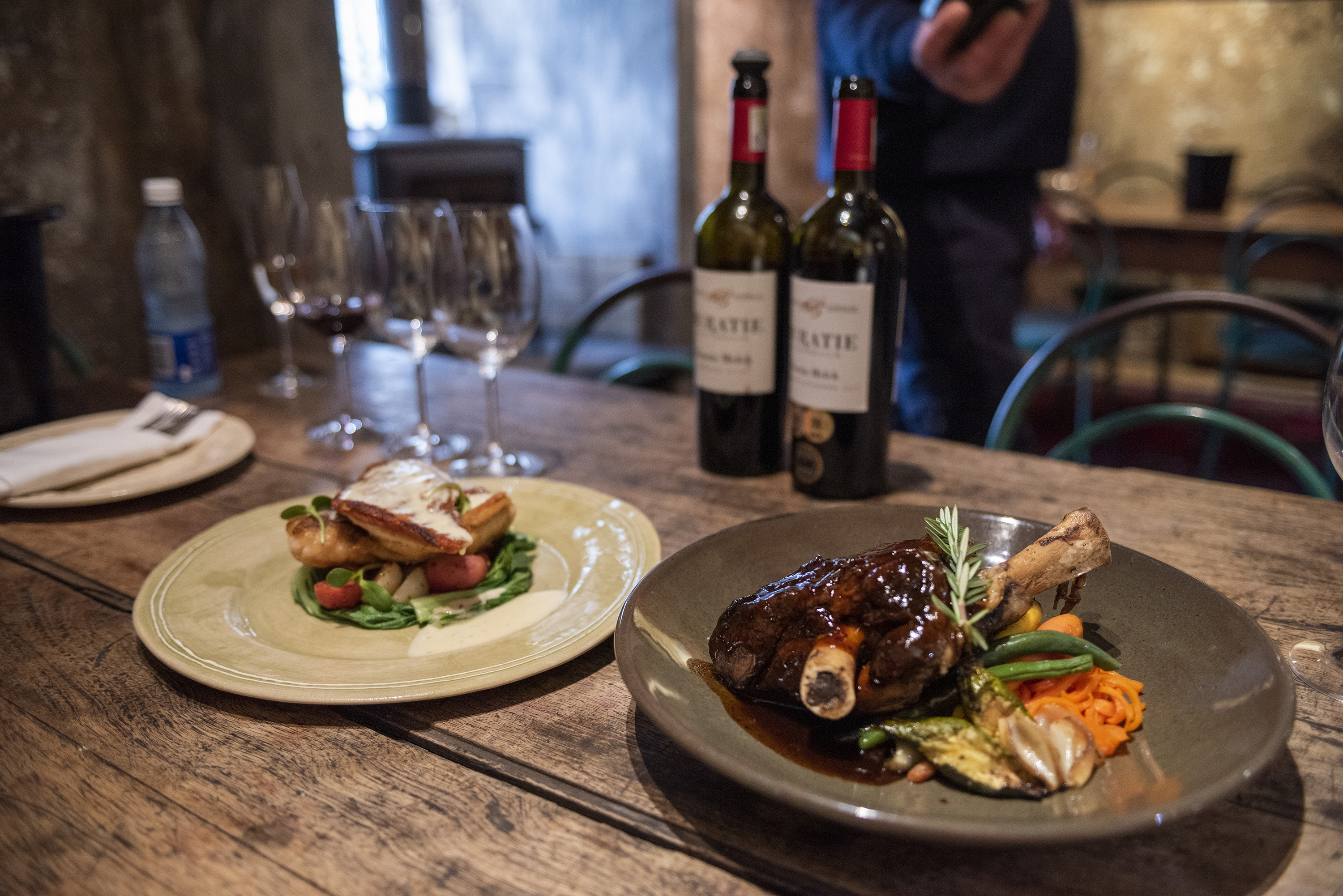
Chef Riaan van Schalkwyk keeps the authentic farm kitchen vibe going with hearty dishes loaded with fresh vegetables from the Muratie vegetable garden. On our first visit we devoured this beautiful red roman with chardonnay cream and slow braised lamb shank in a rich jus. (Photo: Patrick Heathcock)
Rijk’s wife Kim now joins us and we chat about the other long-standing favourite on the Muratie menu. Kim started cooking lamb shanks for Rijk’s business lunches or private tour groups in an improvised kitchen off the tasting room. “That’s all I cooked, the kitchen was the size of a couch, it was tiny.” The lamb shanks, for which she combined her mother and her mother-in-law’s recipes, went down a storm and they decided to open a simple farm restaurant, where Kim cooked herself for several years. But it got to be too much, so they looked for a chef.
“It took a while to find like-minded thinking,” Rijk says, “We don’t want deconstructed cooking. It’s a farm kitchen, there is beauty in simplicity. For me it’s about having a good plate of food with a good glass of wine.”
Once the restaurant was running smoothly without her, Kim turned her hand to baking: rusks, peanut butter cookies and nougat, home bakes with quality ingredients which are sold only through the cellar here. She’d always had a yen to make nougat and started back in 2010, “I found a recipe and made it in small batches in a home beater, then eventually it morphed into a 20 litre drum.” She uses honey from the farm hives and eggs from their chickens, who are most definitely free range.
So much have the stories come alive that as we walk back to our car through dripping oak trees and clivias about to come into flower, it’s almost a surprise not to come across George Paul Canitz entertaining his friends with wine and sandwiches outside his artist’s studio. Or Annamie astride her horse, repelling uninvited guests with a shotgun, or any of the previous owners whose stories still resonate among the old walls of a farm where it feels like very little has changed over the centuries. DM/TGIFood
Read more about Muratie Wine Estate here.
Follow Kit Heathcock on Instagram @kitheathcock
The writer supports Ladles of Love feeding the hungry in South Africa.




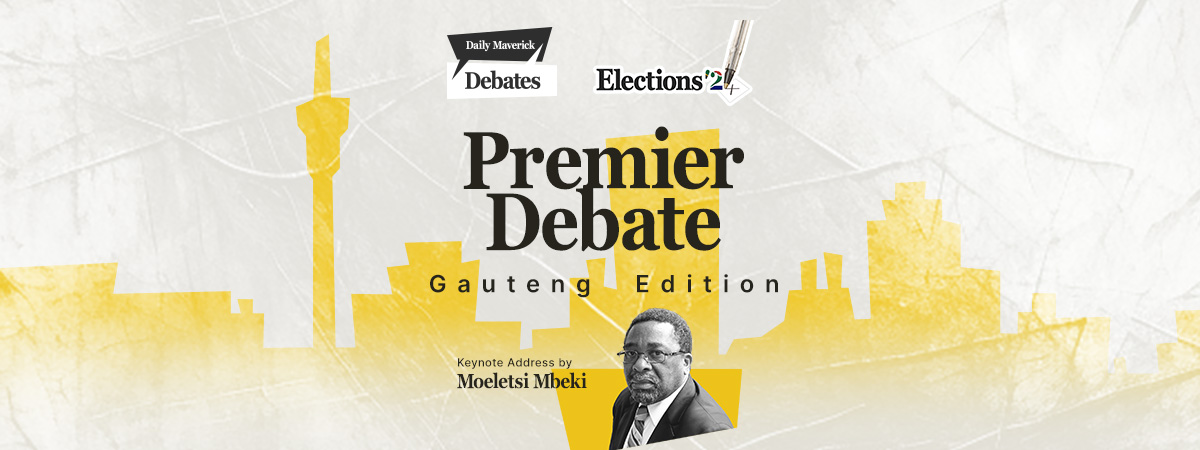

I well remember my first visit to Muratie in the early 1980’s. I was in South Africa on a rugby tour, the Muratie property was very wet and muddy, and thus this was “wellie’s territory”, but it was the warmth, friendliness and character I most remember, that and the big fat, full-bodied red wines, great to drink then and the couple of bottles I managed to keep and get back to England, fabulous drinking some years later when the deep richness, again evoked memories.
Long may Muratie survive and prosper – a wonderful, characterful counter-point to the often anodyne modern wine farms – not all are like this of course, but too many are.
And thus began a love affair with South African wines, which results, now, nearly 50 years later in my very fine, 2,500 bottle wine cellar here in the Hoedspruit bush!!!
Lovely, insightful account.
What a fascinating story. And how lovely that there are still some of these precious spots around South Africa. Enjoyed this article so much.
Is it known that Murati produced the 1st pinot noir in SA (I stand to be corrected)? I had the privilege and good fortune to have tasted it in 1980. The then winemaker, Prins, after a long chat, filled 6 bottles for me by hand straight from the barrel. Even in those years, Murati had a unique and special character.
I’m reading this article from the comfort of a raging fire in the GP Canitz cottage on the Muratie estate. Explore their website to the right corners and you can do it too! There are many options on the Stellenbosch wine route that will satisfy your requirements and tick your boxes. I think this one is a little different, very out of the ordinary and well worth exploring. There is a fine line between respecting the history and moving with the times, I feel the Melcks are pulling this one off and well worth supporting.
Curry afval. My ultimate.
Lovely piece.